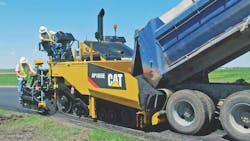Rubber tracked asphalt pavers distribute, shape, and compacts “asphaltic concrete”—a material that includes various formulations that combine graded aggregate, liquid asphalt, and sometimes additives to yield special properties.
The most widely used asphalt, “hot mix,” is produced at temperatures of 275F to 300F and is typically the material chosen for roadways, parking lots, and other large projects. Other types include “warm-mix,” produced at lower temperatures to conserve fuel and to limit emissions, as well as “cold-mix,” typically used for smaller projects and usually employing liquid asphalt emulsified with water prior to mixing with the aggregate.
What does an asphalt paver do?
To place these materials, tracked asphalt pavers are available in a wide range of sizes, from those that pave four feet wide for building walking paths, to those that can attain paving widths of 60 feet or more when placing interstate highways. Machines include two basic units: the tractor, propelled by crawler-type tracks, and a floating screed at the rear of the machine.
The tractor portion incorporates a hopper in the front that receives material from a dump truck or from a material-transfer vehicle, the latter serving as a non-contact intermediary between the dump truck and the paver, eliminating truck-to-paver contact that could affect the smoothness of the “mat” (the placed asphalt).
Depending on the design, material from the hopper flows to the front of the screed by several means: gravity; slat-type conveyors; or augers. Some have control gates that raise and lower automatically to control the volume of material reaching the screed, where augers then spread the material evenly across the front of the screed. The screed is basically a heavy metal plate that shapes the pliant asphalt. The screed also is heated (usually by electricity, sometime with fuel), and it vibrates to increase the material’s density. Some pavers also use tamper bars ahead of the screen to aid in achieving initial density.
How does an asphalt paver work?
The screed levels and partially compacts the asphalt material to the project’s specified thickness, grade, slope, and crown profile. The screed is attached to the tractor with tow arms, mounted on each side of the tractor, providing a means for adjusting the screed to control material thickness. The asphalt paver follows a reference point to control the screed, often using sonar sensors that follow an existing surface.
Electronic control systems using digital project maps in conjunction with universal total stations or satellite guidance have allowed even precise control of the screed, resulting in mats that are exceeding smooth. (Final density is achieved with compaction rollers.) In addition, most of these machines are equipped with control stations that promote the safety, comfort, and efficiency of the operator.

